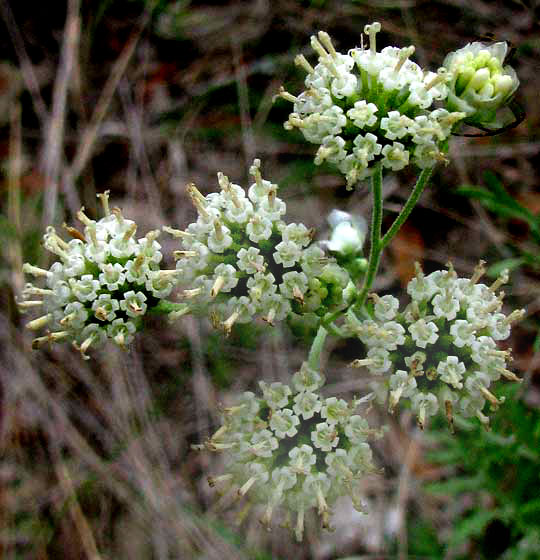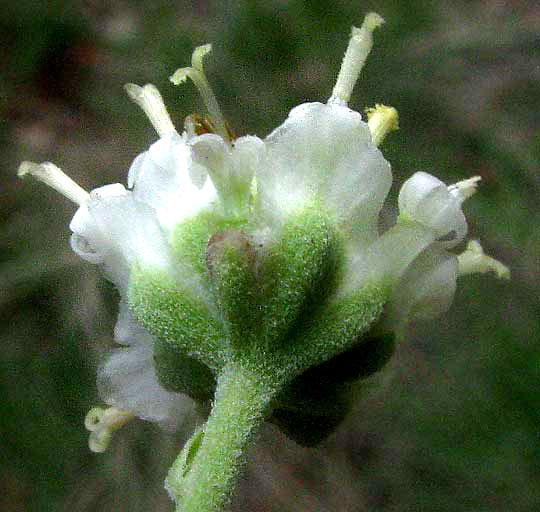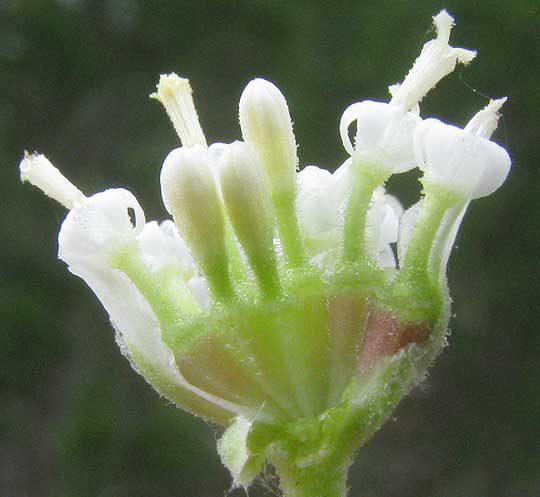Excerpts from Jim Conrad's
Naturalist Newsletter
from the June 9, 2013 Newsletter issued from the Frio Canyon Nature Education Center in northern Uvalde County, southwestern Texas, on the southern border of the Edwards Plateau; elevation ~1750m (~5750 ft); N29.62°, W99.86°; USA
OLD PLAINSMAN

Here and there in the Ashe Juniper and Texas Live Oak forests mantling limestone hills along the Dry Frio Valley, the trees thin out and sometimes even break into open grassy areas, which I think of as prairie patches. Sometimes these patches occur where soil is so thin and dry atop the limestone that it's understandable why grass grows there but not trees. Other times it's hard to say why the patches occur where they do.
Just as in the vast prairies to our north, these grassy areas are home to much more than grasses. A surprising variety of wildflowers and small shrubs grow there, except where local ranchers kill the Ashe Junipers and introduce livestock, and then of course the natural vegetation is replaced by mostly alien grasses and bare ground.
One wildflower now blossoming in our hillside prairie patches is shown at the right. From a distance it looks just like many nondescript species topped with clumps of little white flowers, but when you begin "doing the botany" you find fascinating innovations that define the species, and unexpected prettiness.
The leaves have some personality, being deeply lobed, and the lobes themselves having lobes, as shown below:

On that leaf, notice how the bases of the main lobes extend onto the midrib creating green "wings" on both sides of the midrib. The leaf does have some character, but it's the flowers that capture our attention. Look how tiny white ones cluster into heads which themselves cluster into larger heads below:

Those familiar with wildflowers might find these flower cluster reminiscent of those of the Parsley Family, maybe like a cross between Queen Anne's Lace and garden Dill, both of which belong to the Parsley Family. However, even at the distance at which the above photograph was taken we can see that poking from each tiny, white flower there's a Y-shaped style, the base of which is surrounded by five anthers fused to one another along their sides forming a cylinder around the style base, so right there we know we have a member not of the Parsley Family but of the vast Composite or Daisy Family.
When diagnosing a member of that family one of the first things you must do is to look under one of the ultimate flower clusters to see what the calyx-like "involucre" looks like, so that's shown below:

In the Composite Family most involucres are composed of more green, scale-like "phyllaries" than is shown here. Normally there are so many phyllaries that they're arrayed in rows and overlap one another like roof shingles. Having so few phyllaries in a single row is a good field mark for this species.
However, there's something else that's almost amazing here, something you almost overlook if you're not paying attention. And that is that in this species the tips of the phyllaries, instead of coming to a point as in the vast majority of species, turn white and flair out, looking almost like flower petals. Very few composite flowers do that. In most species of the Composite Family, if there are petal-like items radiating away from a central "eye, those petal-like things are ray flowers surrounding the "eye" composed of disk flower. Some Composite species have only ray flowers and others only disk flowers. The species we're dealing with now produces only disk flowers, with no petal-like ray flowers, but the phyllaries, which in most species are green, are white, and function as petal-like ray flowers. This is a field mark worth remembering.
Despite having noticed such a remarkable field mark, it's still worth breaking open a head to see what the disk flowers look like inside the head, and that's shown below:

Here we see that no scale-like "paleae" separate the individual disk flower bases, and that there's not much of a pappus atop the future fruits, or cypselae. With higher magnification we'd see that the pappus consists of a dozen or so low, rounded scales.
What we have here is a wildflower graced with the evocative name Old Plainsman -- also called Woolly-White, Carolina Woollywhite, and White-bract Hymenopappus. The name Old Plainsman cues us to the fact that this plant is a distinctive species of dry, open prairies of the Great Plains north of us. It's HYMENOPAPPUS SCABIOSAEUS var. CORYMBOSUS, a biennial that spends its first season as a rosette of leaves hugging the ground.
Usually I don't mention variety names, but in this case the evolutionary fracturing of the species has progressed to the point that the two varieties are so near to becoming species that some experts have made them into their own species -- but not the online Flora of North America.
Our variety corymbosus occurs on clay and/or calcareous soil on limestone and in grasslands from Kansas south through here into Coahuila state in northeastern Mexico.
The variety scabiosaeus inhabits sandy soils in openings in pine and/or oak woodlands in the US Deep South and in the interior north to Indiana.